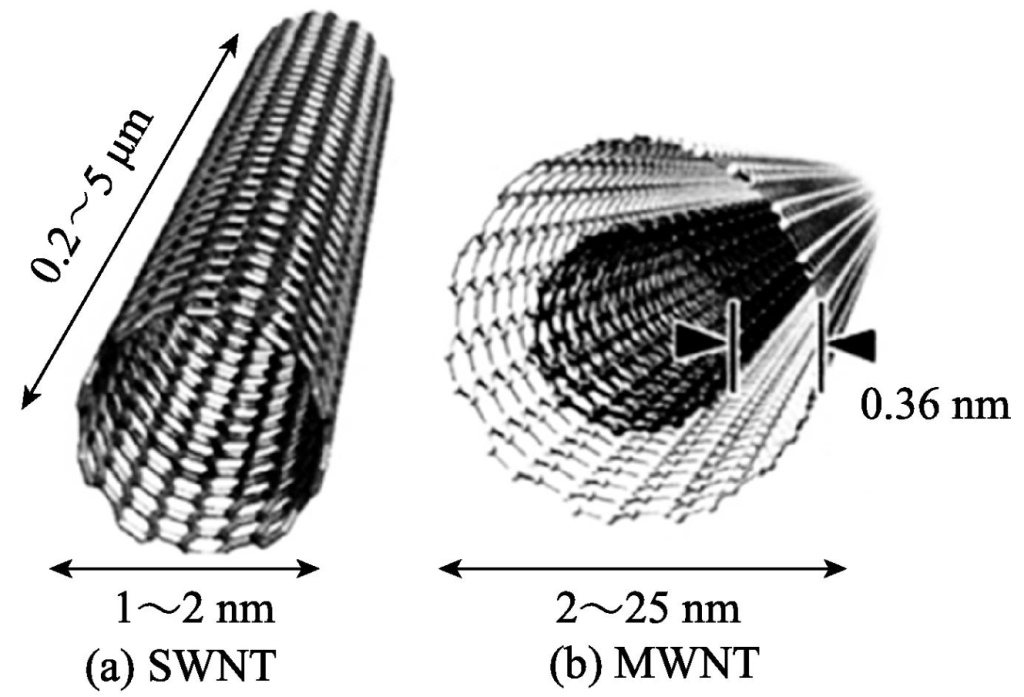Carbon Nanotubes as Electrode Materials in Supercapacitors: Applications, Advantages, and Challenges
Supercapacitors, also known as ultracapacitors, are advanced energy storage devices that combine high power density with rapid charge and discharge capabilities. Carbon nanotubes (CNTs) have emerged as a key material for enhancing supercapacitor performance due to their exceptional electrical, mechanical, and structural properties. This article explores the application of CNTs in supercapacitors, their unique advantages, real-world applications, and the challenges faced in achieving widespread adoption.

How Carbon Nanotubes Are Used in Supercapacitors
Carbon nanotubes are primarily utilized as electrode materials in supercapacitors. Their high electrical conductivity and large surface area make them ideal for facilitating electrochemical reactions and charge storage. There are two main mechanisms for energy storage in supercapacitors:
- Electrical Double-Layer Capacitors (EDLCs)
CNTs store energy through electrostatic charge accumulation at the electrode-electrolyte interface. Their high aspect ratio and porous structure enhance the effective surface area for charge storage, leading to increased capacitance. - Pseudocapacitors
Functionalized CNTs, often combined with metal oxides (e.g., MnO₂, RuO₂) or conductive polymers (e.g., polyaniline, polypyrrole), enable faradaic reactions. This hybrid approach combines the benefits of EDLCs and pseudocapacitance, boosting energy density.
Electrode Fabrication
CNT-based electrodes are typically fabricated using techniques such as:
- Spray coating or spin coating: to form thin, uniform films.
- Electrophoretic deposition: to create well-dispersed electrode layers.
- Direct growth on substrates: for vertically aligned CNT arrays.
Advantages of Using Carbon Nanotubes in Supercapacitors
1. High Surface Area
CNTs offer a specific surface area of up to 1000 m²/g, providing ample space for charge storage and ensuring high capacitance.
2. Superior Electrical Conductivity
With electrical conductivity reaching 10610^6106 S/m, CNTs reduce internal resistance, enabling rapid charge and discharge cycles with minimal energy loss.
3. Mechanical Durability
CNTs’ excellent mechanical properties ensure electrode stability during repetitive cycling, extending the lifespan of supercapacitors.
4. Thermal Stability
CNTs can withstand high temperatures, making them suitable for applications requiring robust thermal performance.
5. Flexibility
Their flexibility allows for the fabrication of lightweight, bendable supercapacitors, which are critical for wearable electronics and flexible energy storage devices.
Real-World Applications of CNT-Based Supercapacitors
1. Transportation
- Electric Vehicles (EVs): Supercapacitors enhanced with CNTs support regenerative braking systems by storing and releasing energy quickly.
- Public Transit: Buses in cities like Shanghai use CNT-based supercapacitors for rapid charging at stops.
2. Renewable Energy Storage
CNT-enhanced supercapacitors are used to stabilize power grids, storing excess energy from solar panels and wind turbines for later use.
3. Consumer Electronics
Wearable devices, smartphones, and other portable electronics benefit from the compact size and rapid charging capabilities of CNT-based supercapacitors.
4. Aerospace and Defense
In aerospace applications, CNT-based supercapacitors provide reliable energy storage for satellites, drones, and military systems requiring lightweight and durable energy solutions.
5. Industrial Systems
Supercapacitors with CNT electrodes are used in robotics, manufacturing systems, and heavy machinery to ensure uninterrupted power during peak loads.
Market Trends and Adoption
Global Market Size
The supercapacitor market was valued at approximately USD 6 billion in 2023 and is expected to grow at a CAGR of 14–16% over the next decade, with CNT-based supercapacitors playing a pivotal role in this expansion.
Key Players
Major companies like Skeleton Technologies, Maxwell Technologies, and Panasonic are incorporating CNTs into their supercapacitor designs to achieve superior performance.
Regional Growth
- Asia-Pacific: Leading the market due to extensive adoption in EVs, renewable energy projects, and consumer electronics.
- North America and Europe: Witnessing growing demand for industrial applications and green energy storage solutions.
Challenges in the Use of Carbon Nanotubes for Supercapacitors
1. High Cost of CNT Production
CNTs, particularly single-walled CNTs (SWCNTs), remain expensive to produce due to sophisticated manufacturing processes like chemical vapor deposition (CVD). Cost-effective production methods are needed to enable mass adoption.
2. Dispersion and Integration
Achieving uniform dispersion of CNTs in electrode formulations is challenging, as CNTs tend to aggregate. This affects the electrode’s performance and scalability.
3. Compatibility with Electrolytes
CNTs must be chemically stable in various electrolytes (e.g., aqueous, organic, ionic liquids) to ensure long-term performance. Functionalization may be required, which can increase complexity and costs.
4. Environmental Concerns
CNT production and disposal raise environmental and health concerns. Developing eco-friendly production methods and recycling processes is essential for sustainable growth.
5. Limited Energy Density
While CNTs significantly improve power density, their energy density still lags behind that of traditional batteries. Combining CNTs with advanced materials like graphene or metal oxides is a potential solution.
Future Prospects
The integration of CNTs in supercapacitors is expected to advance with ongoing innovations in material synthesis and electrode design. Emerging research focuses on hybrid materials that combine CNTs with graphene, conductive polymers, and nanostructured metal oxides to achieve breakthroughs in energy and power densities.
As manufacturing costs decrease and scalability improves, CNT-based supercapacitors will likely find broader applications in sectors demanding efficient, durable, and high-performance energy storage solutions.
Conclusion
Carbon nanotubes are revolutionizing the field of supercapacitors by addressing key limitations in conductivity, mechanical stability, and charge-discharge efficiency. Their unique properties enable the development of next-generation supercapacitors for applications ranging from transportation to renewable energy storage.
However, challenges such as high production costs, integration difficulties, and environmental concerns must be addressed to unlock their full potential. With continued advancements in CNT technology and growing demand for sustainable energy solutions, CNT-based supercapacitors are poised to play a significant role in the future of energy storage.

